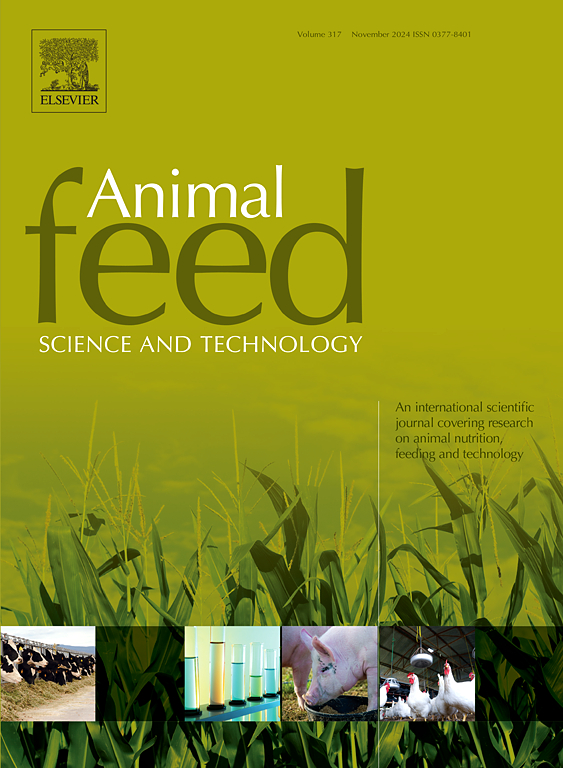背景期和育肥期营养平面和饲粮蛋白质水平影响肉牛氮和水分代谢
IF 2.7
2区 农林科学
Q1 AGRICULTURE, DAIRY & ANIMAL SCIENCE
引用次数: 0
摘要
本研究旨在研究育肥期(BP)和肥育期(FP)两个阶段不同营养平面对肉牛氮代谢的影响,从而影响肉牛的需水量。选用24头安格斯阉牛(298.01 ± 10.17 kg),采用完全随机设计,采用2 × 2因子处理(两期两营养平面)。BP期(85 d)和FP期(105 d);营养水平适中(MP;粗蛋白质- cp: 9.10 %)或高蛋白质(HP;CP: 12.62 %)用于BP和饲料(优质苜蓿干草;CP: 21.3% %)或成品谷物(80% %全玉米和20% %苜蓿干草;CP: 10.8 %))。BP和FP对干物质采食量(DMI)、n摄食量(g/d)、粪氮(g/d)、尿氮(n排泄的百分比)和总n排泄(g/d)有显著的交互作用(P <; 0.1)。微生物氮与微生物蛋白合成无交互作用(P >; 0.1)。饲喂HP饲料的动物排泄尿氮和粪氮较少,因此保留了更多的氮(P <; 0.01),与MP动物相比,提高了氮效率(P <; 0.01)。饮水量和微生物氮无显著差异(P >; 0.05)。与草食牛相比,粗粮饲牛的氮和水消耗更少,粪氮和尿氮排泄最低,氮潴留率和氮吸收利用率更高(P <; 0.05)。饲喂HP的动物DMI N排泄、粪便排出量和粪氮含量最低(P <; 0.05)。在背景环境中接受HP的牛将在不改变所需水量的情况下减少其n排泄,同时由于更有效的n循环而产生相同数量的微生物n。当这些动物过渡到以谷物为食的肥育系统时,这种氮和水利用效率模式继续存在。本文章由计算机程序翻译,如有差异,请以英文原文为准。
The plane of nutrition and dietary protein level during backgrounding and finishing phases affect nitrogen and water metabolism in beef cattle
This study aimed to examine how varying planes of nutrition during the two phases: backgrounding (BP) and finishing (FP) impact nitrogen (N) metabolism and, consequently, the water requirements of beef cattle. Twenty-four crossbred Angus steers (298.01 ± 10.17 kg) were randomly distributed in a completely randomized design following a 2 × 2 factorial arrangement of treatments (two phases and two nutritional planes). The phases being BP (85 d) and FP (105 d); and plane of nutrition being moderate (MP; crude protein-CP: 9.10 %) or high (HP; CP: 12.62 %) for BP and forage (high-quality alfalfa hay; CP: 21.3 %) or grain-finished (80 % whole corn and 20 % alfalfa hay; CP: 10.8 %)) for FP. There was a significant interaction between BP and FP (P < 0.1) for dry matter intake (DMI), N-ingested (g/d), fecal (g/d), N-urinary (% of N-excreted), and total N-excreted (g/d). There was no interaction observed for microbial N and microbial protein synthesis (P > 0.1). Animals fed HP diets excreted less N-urinary and N-fecal and therefore retained more N (P < 0.01), increasing N-efficiency (P < 0.01) compared to MP animals. No differences were observed for water intake or microbial-N (P > 0.05). Grain-fed cattle consumed less N and water compared to forage-fed cattle, as well as the lowest excretion of N-fecal and urinary-N, and higher rate of N-retained and higher efficiency on utilizing the N-intake (P < 0.05). Animals fed HP lowest DMI N excretion, fecal output, and N-fecal (P < 0.05). Cattle receiving HP during backgrounding will reduce their N-excretion without modifying the required amount of water while producing the same amount of microbial-N due to more efficient N-recycling. This N and water use efficiency pattern carried over when these animals transitioned to grain-fed finishing systems.
求助全文
通过发布文献求助,成功后即可免费获取论文全文。
去求助
来源期刊

Animal Feed Science and Technology
农林科学-奶制品与动物科学
CiteScore
6.00
自引率
6.20%
发文量
266
审稿时长
3 months
期刊介绍:
Animal Feed Science and Technology is a unique journal publishing scientific papers of international interest focusing on animal feeds and their feeding.
Papers describing research on feed for ruminants and non-ruminants, including poultry, horses, companion animals and aquatic animals, are welcome.
The journal covers the following areas:
Nutritive value of feeds (e.g., assessment, improvement)
Methods of conserving and processing feeds that affect their nutritional value
Agronomic and climatic factors influencing the nutritive value of feeds
Utilization of feeds and the improvement of such
Metabolic, production, reproduction and health responses, as well as potential environmental impacts, of diet inputs and feed technologies (e.g., feeds, feed additives, feed components, mycotoxins)
Mathematical models relating directly to animal-feed interactions
Analytical and experimental methods for feed evaluation
Environmental impacts of feed technologies in animal production.
 求助内容:
求助内容: 应助结果提醒方式:
应助结果提醒方式:


